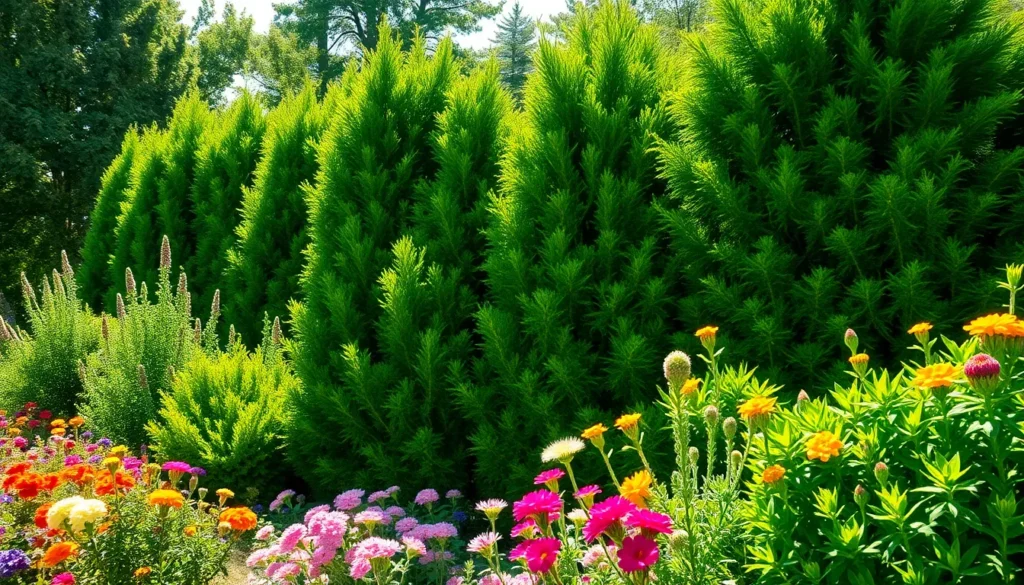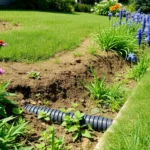Strong winds can turn our beautiful gardens into battlegrounds where plants struggle to survive. We’ve all watched helplessly as gusts snap delicate stems bend tree branches and scatter mulch across freshly planted beds. Creating effective windbreaks isn’t just about protection—it’s about transforming our outdoor spaces into thriving sanctuaries where plants can flourish year-round.
The right windbreak design does more than shield our gardens from harsh weather. It creates microclimates that extend growing seasons reduces water evaporation and provides wildlife habitat. Whether we’re dealing with coastal winds prairie gusts or mountain breezes there’s a windbreak solution that fits our industry and budget.
From living hedges and strategic tree placement to creative fence designs and temporary barriers we’ll explore proven windbreak ideas that work. These answers blend functionality with beauty ensuring our gardens stay protected while maintaining their visual appeal throughout every season.
Natural Living Windbreak Ideas Using Trees and Shrubs
Natural windbreaks offer the most sustainable and beautiful solution for garden protection. Living barriers mature over time to create increasingly effective wind shields while adding ecological value to our outdoor spaces.
Evergreen Tree Barriers for Year-Round Protection
Spruce trees provide exceptional wind resistance with their dense, pyramid shaped canopies that maintain full coverage throughout winter months. Norway spruce grows rapidly at 1-2 feet per year and reaches mature heights of 40-60 feet, making it ideal for large property perimeters.
Arborvitae creates uniform wind walls when planted in rows with 6-8 foot spacing between individual trees. These columnar evergreens like Green Giant arborvitae can reach 20-30 feet tall while maintaining narrow 6-8 foot widths, perfect for smaller gardens.
Pine varieties offer diverse windbreak options depending on our exact climate zones and soil conditions. Eastern white pine thrives in cooler regions and provides soft needle texture, while Austrian pine handles urban pollution and harsh winds in city gardens.
Fir trees establish dense lower branches that block wind at multiple levels from ground to canopy height. Balsam fir works well in northern climates, while Douglas fir adapts to various soil types and moisture conditions across different regions.
Deciduous Tree Options for Seasonal Windbreaks
Maple trees create broad canopies that deflect summer winds while allowing winter sun to reach our gardens after leaves drop. Sugar maples provide brilliant fall color and grow 1-2 feet annually to reach 60-75 foot mature heights.
Oak species develop massive wind resistant trunks and spreading branch structures that withstand severe weather conditions. White oaks live for centuries and create substantial barriers, while red oaks grow faster and adapt to various soil types.
Willow trees grow rapidly to establish quick windbreak coverage in wet or challenging soil conditions. Weeping willows reach 25-40 feet tall within 10-15 years, though they require regular pruning to maintain desired shapes.
Poplar varieties provide fast growing screens that can reach 30-50 feet in just 10-20 years of growth. Lombardy poplars create narrow columnar shapes ideal for property lines, while eastern cottonwoods spread wider for broader wind protection.
Dense Shrub Hedges for Lower-Level Wind Protection
Privet hedges form thick barriers when planted 2-3 feet apart and maintained at 4-8 foot heights through regular trimming. California privet grows quickly and tolerates heavy pruning, while Japanese privet offers better cold hardiness in northern gardens.
Boxwood creates formal windbreak hedges that can be shaped into precise geometric forms while providing dense year round coverage. English boxwood maintains compact growth habits, while American boxwood handles temperature extremes better in harsh climates.
Barberry shrubs develop thorny barriers that deter both wind and unwanted visitors while requiring minimal maintenance once established. Japanese barberry offers colorful foliage options, while common barberry provides traditional green coverage.
Viburnum species combine wind protection with seasonal flowers and attractive berries that support local wildlife populations. Arrowwood viburnum adapts to various growing conditions, while Korean spice viburnum adds fragrant spring blooms to our garden windbreaks.
Structural Windbreak Ideas for Immediate Protection
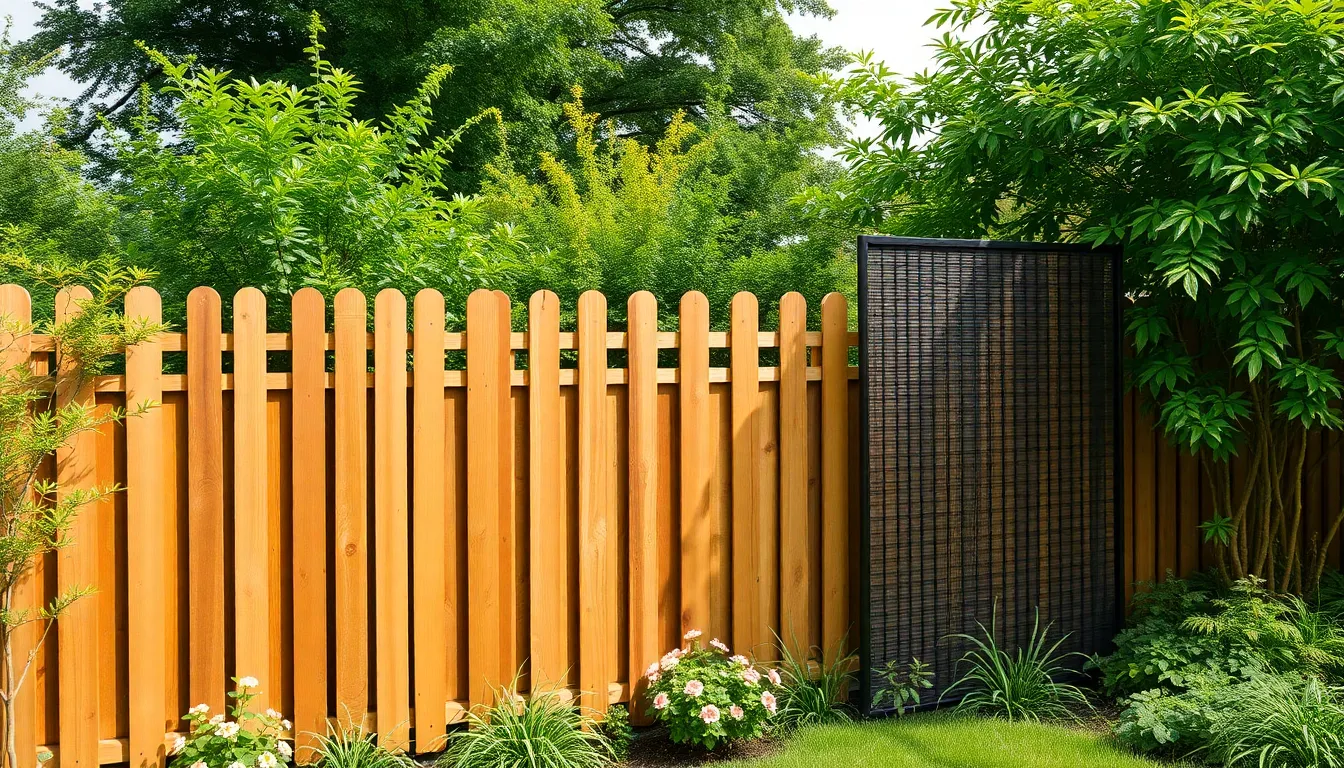
When you need wind protection right away, structural windbreaks offer the fastest solution for your garden. These built barriers provide instant defense against harsh winds while you wait for living windbreaks to mature.
Wooden Fence Windbreaks with Strategic Gaps
Wooden fences with deliberate spacing deliver superior wind protection compared to solid barriers. Strategic gaps between slats allow controlled airflow while reducing wind speed effectively. Spacing boards 1 1/2 to 4 inches apart creates the optimal balance between protection and pressure relief.
Horizontal slats perform better than vertical ones for most garden applications. We recommend maintaining 2 to 3 inch gaps between boards to maximize effectiveness. Wider gaps reduce protection while narrower spacing increases wind pressure buildup that can damage the fence structure.
Ground level openings prevent common fence problems and extend lifespan. Leave 4 to 6 inches of clearance at the bottom to allow drainage and airflow beneath your fence. This design choice prevents wood rot and maintains structural integrity over time.
Bamboo Screen Installations for Natural Appeal
Bamboo screens combine immediate wind protection with tropical garden aesthetics. These lightweight panels install quickly as rolls or individual sections. Bamboo’s natural flexibility allows it to bend with strong winds rather than break under pressure.
Semi permeable bamboo barriers reduce wind speed while maintaining gentle airflow. The natural spacing between bamboo canes creates an effective windbreak that doesn’t block all air movement. This feature prevents the pressure buildup that solid barriers experience during storms.
Installation versatility makes bamboo screens adaptable to various garden layouts. Mount them on existing posts or create standalone barriers using bamboo poles as support structures. The natural material blends seamlessly with garden environments while providing moderate wind protection.
Metal and Wire Mesh Windbreak Answers
Metal windbreaks require careful design to achieve effective wind reduction. Wire mesh with wide gaps allows too much air passage and provides minimal protection. Closely spaced metal slats or sheets create better barriers but need proper engineering to handle wind loads.
Galvanized metal with horizontal rails offers maximum durability for permanent installations. These structures resist corrosion and maintain their protective qualities for decades. But, metal barriers can create sharp edges that pose safety risks in garden settings.
Post spacing becomes critical for metal windbreak stability and longevity. Install posts 6 to 8 feet apart for dense metal barriers or extend to 8 to 10 feet for lighter structures. Dig post holes to 1/3 the above ground height plus 6 inches, using concrete in high wind areas for maximum stability.
Temporary Garden Windbreak Ideas for Quick Setup
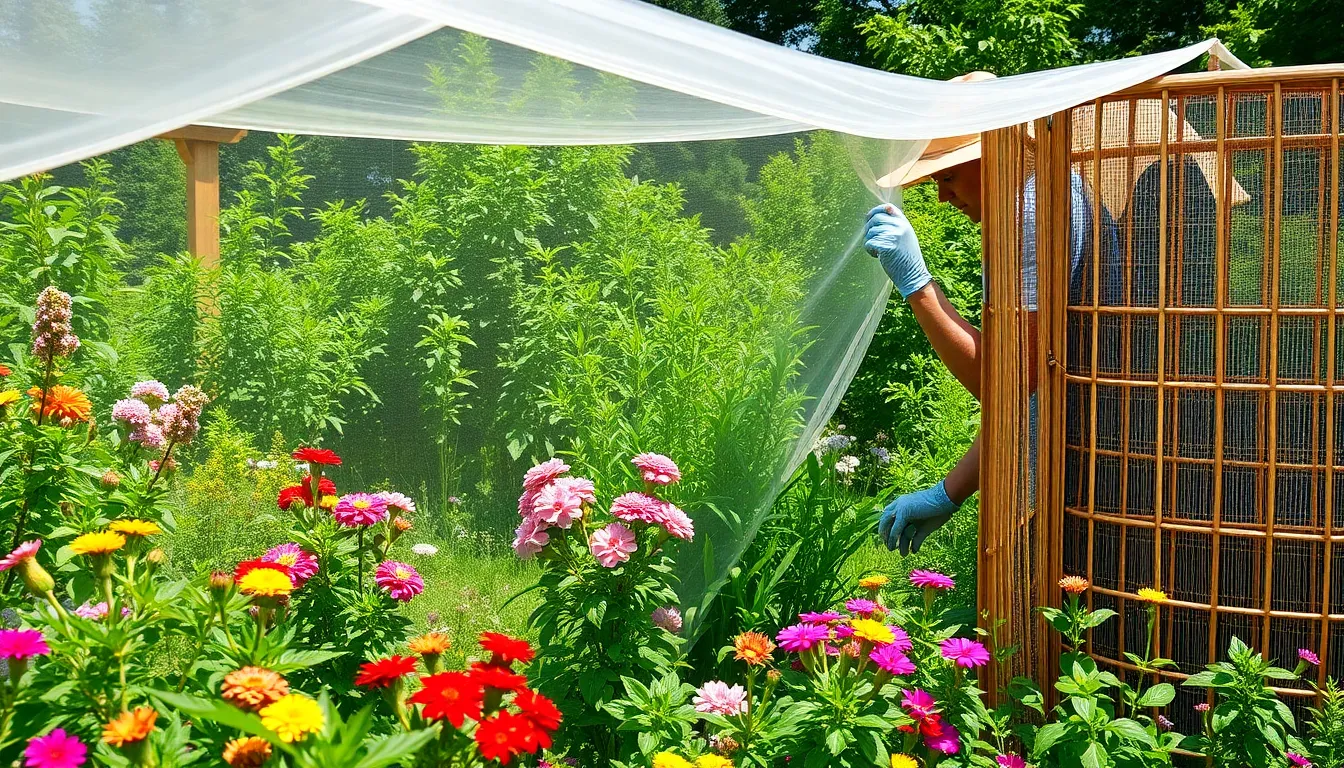
When we need immediate wind protection while our permanent answers take root, temporary windbreaks offer the perfect bridge solution. These quick setup options provide instant relief from harsh winds without the long-term commitment of permanent structures.
Fabric and Tarp Windbreak Systems
Clear tarps with grommets create an effective barrier that blocks wind while maintaining visibility across your garden space. We recommend positioning these transparent barriers along the windward side of vulnerable plants to deflect gusts without creating a visual obstruction. Custom shape tarps allow us to tailor wind protection to exact garden areas, whether we’re protecting a corner vegetable patch or shielding delicate flowering borders.
Fabric windbreak systems excel at reducing wind speed by 50-70% while allowing some airflow to prevent damaging turbulence. These lightweight answers attach easily to existing fence posts or temporary supports, making them ideal for renters or gardeners who frequently rearrange their outdoor spaces.
Portable Screen Panels for Flexible Placement
Bamboo screens provide our gardens with lightweight, moveable wind protection that we can reposition throughout the growing season. These natural barriers offer excellent airflow regulation while maintaining an organic aesthetic that complements most garden designs. Freestanding windbreak panels deliver instant protection wherever we need it most, requiring no permanent installation or structural modifications.
Portable screen systems typically reduce wind speed by 40-60% depending on their density and height. We can arrange multiple panels in various configurations to create custom wind corridors or temporary enclosures around sensitive plantings during severe weather events.
Stakes and Netting for Seasonal Protection
Stakes with netting create an affordable windbreak solution that we can install and remove based on seasonal needs. This combination works particularly well for protecting annual crops or newly planted perennials during their establishment period. T-posts with fencing installed at 7-foot heights provide robust temporary protection until our permanent windbreak plantings mature and take over the wind blocking duties.
Netting systems allow approximately 30-40% of wind to pass through while breaking up harmful gusts that could damage plant stems or desiccate foliage. We find these answers especially valuable during transition seasons when wind patterns shift and our gardens need extra protection while adapting to changing conditions.
Creative DIY Windbreak Ideas Using Recycled Materials
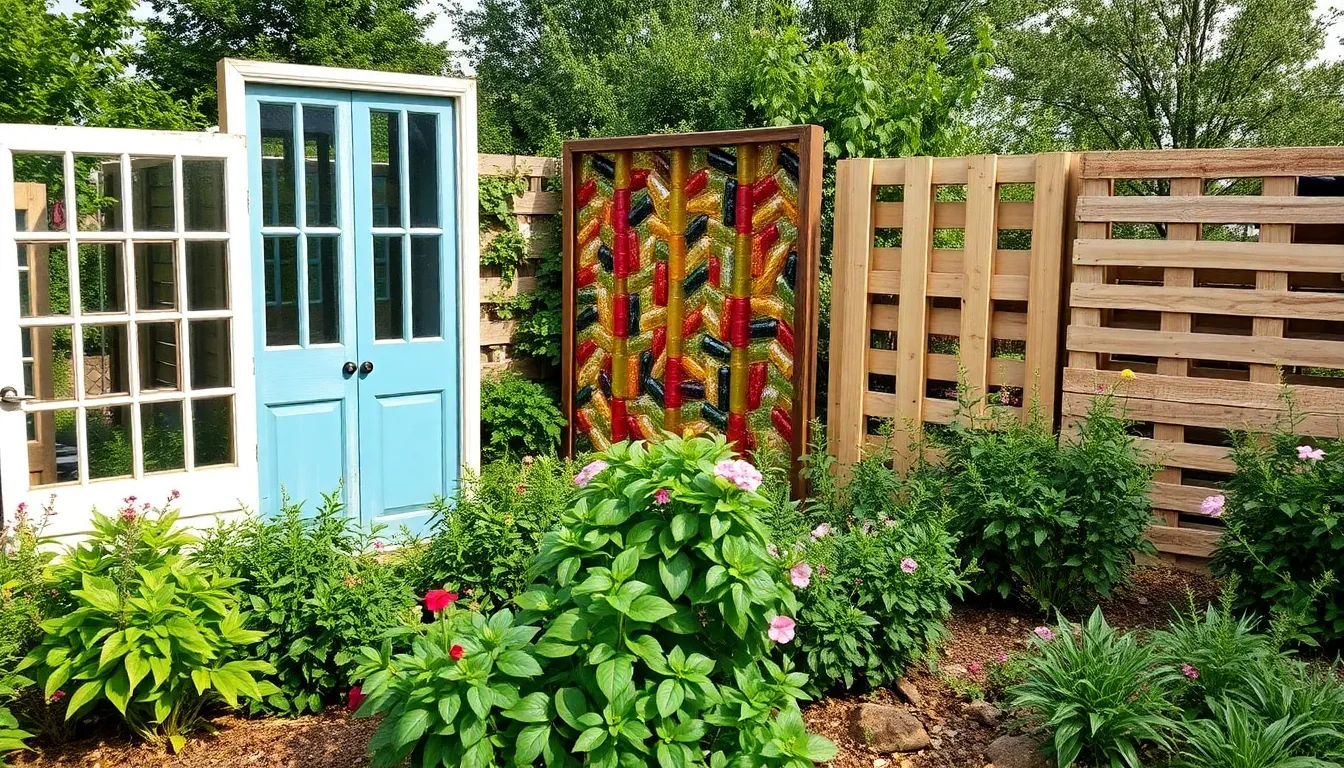
Transforming discarded materials into effective garden windbreaks combines sustainability with smart gardening. We can create impressive wind barriers while reducing waste and saving money on expensive commercial options.
Repurposed Window and Door Windbreak Screens
Old windows and doors offer exceptional materials for creating decorative windbreak screens that protect our gardens with vintage charm. We transform these discarded building materials by repairing damaged panes and assembling multiple windows vertically to form semi-transparent barriers. The glass panels effectively diffuse strong winds while maintaining visibility and light transmission to our plants.
Mounting old doors side by side creates solid windbreak walls that block harsh gusts completely. We secure these repurposed barriers by anchoring them to sturdy posts driven deep into the ground. The weathered wood and unique architectural details add character to our garden spaces while providing essential wind protection for delicate plants.
Recycled Plastic Bottle Wind Barriers
Plastic bottles become lightweight and budget-friendly windbreak materials when we cut and arrange them into protective panels. We create strips from large bottles and attach them to wire frames or wooden supports to form flexible barriers. These recycled wind screens effectively reduce wind intensity while adding colorful elements to our garden design.
Converting plastic bottles into wind spinners and windmills provides dual functionality in our windbreak strategy. We create these rotating devices to visually mark wind patterns and disrupt airflow before it reaches our plants. The spinning motion breaks up strong gusts and creates turbulence that reduces wind force on nearby vegetation.
Salvaged Wood Pallet Windbreak Constructions
Wood pallets from shipping operations provide sturdy foundation materials for constructing durable garden windbreaks. We dismantle these pallets and fasten the planks to vertical posts or use intact pallets as instant wall sections. The robust construction creates reliable barriers that withstand strong winds while requiring minimal investment.
Customizing pallet windbreaks allows us to adjust height and width based on our exact garden protection needs. We anchor these structures firmly into the soil and reinforce weak spots with additional scrap wood or fabric tarps. The rustic appearance complements natural garden settings while providing professional-grade wind protection for our plants.
Multi-Purpose Windbreak Ideas That Add Garden Value
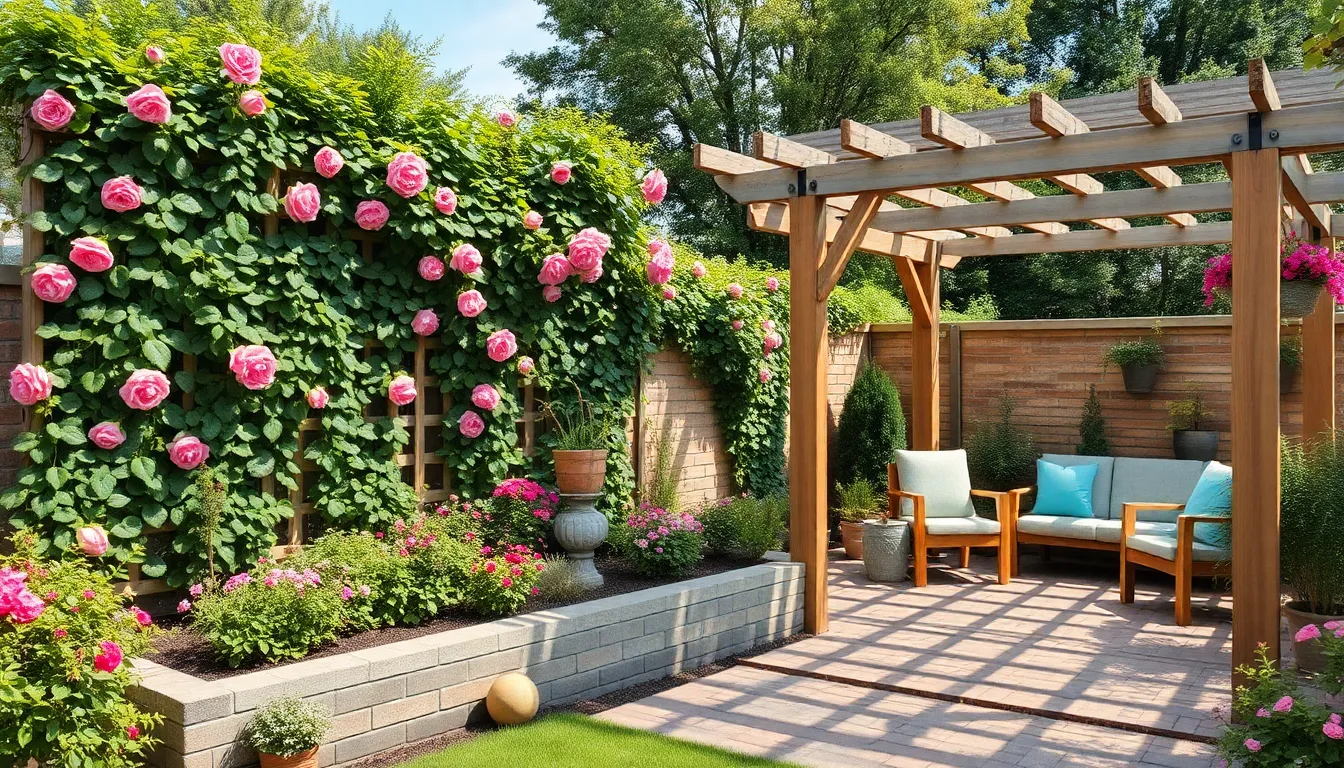
We can maximize our garden’s potential by installing windbreaks that serve multiple functions beyond wind protection. These innovative answers combine practical wind defense with aesthetic appeal and additional garden features.
Trellis Windbreaks Supporting Climbing Plants
Trellis windbreaks offer dual functionality by deflecting wind while providing vertical support for climbing plants like clematis, ivy, and roses. Open lattice designs allow controlled airflow to reduce wind pressure while still offering shelter for sensitive garden areas. These structures enhance garden aesthetics with lush greenery or vibrant flowers growing directly on the windbreak surface.
We recommend positioning trellis windbreaks strategically to protect vulnerable plants while creating beautiful vertical garden displays. The natural integration with climbing vegetation makes these windbreaks blend seamlessly into garden environments. Over time, the growing plants strengthen the wind protection while adding seasonal interest and natural beauty to our outdoor spaces.
Garden Wall Windbreaks with Built-In Planters
Short garden walls constructed from blockwork, timber cladding, or dry stone create solid windbreaks while incorporating built-in planters for decorative or useful planting. These multi-functional features shield against harsh winds and provide dedicated space for herbs, flowers, or small shrubs. Materials like clay, polished concrete, and ceramic tiles add textural interest alongside their practical wind protection benefits.
Wall windbreaks with planters become stylish outdoor focal points that protect seating areas and sensitive plants from wind damage. We can customize the height and planter size based on exact garden needs and wind exposure levels. The integrated planting space allows us to create stunning displays that change with seasons while maintaining year-round wind protection.
Pergola Windbreaks Creating Outdoor Living Spaces
Pergolas with partial side panels or integrated trellises serve as effective windbreaks while defining comfortable outdoor living spaces. Supporting climbing plants and creating overhead shade, these structures offer shelter and comfort that transforms windy garden spots into relaxing retreats. Combined with seating or dining areas, pergola windbreaks reduce wind chill and increase garden usability throughout the year.
We can enhance pergola windbreaks by adding removable panels for seasonal wind protection or incorporating built-in storage for garden tools and cushions. The overhead structure provides additional benefits like rain protection and filtered sunlight for plants below. These versatile windbreaks create intimate outdoor rooms that encourage extended use of garden spaces regardless of weather conditions.
Low-Maintenance Windbreak Ideas for Busy Gardeners
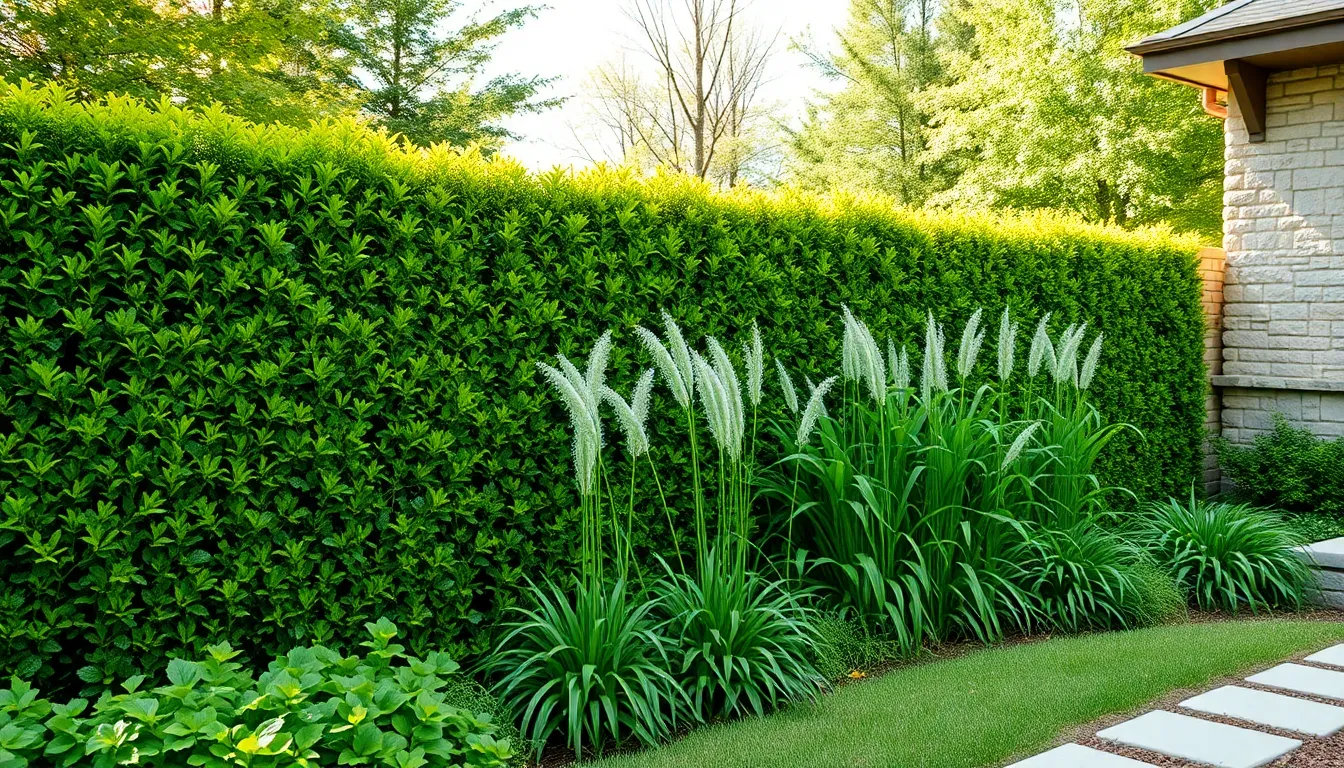
Finding effective wind protection shouldn’t require endless hours of maintenance. We’ll explore practical answers that work immediately and continue protecting your garden with minimal upkeep.
Artificial Hedge Windbreak Answers
Artificial boxwood panels deliver instant windbreak benefits without any maintenance requirements. Installing these synthetic answers makes perfect sense when planting isn’t practical or soil conditions won’t support living hedges.
Windbreak netting shields gardens from wind, sun, and rain while installing quickly for immediate protection. Synthetic materials resist weather damage and require no seasonal care, making them ideal for busy gardeners who need reliable barriers.
Faux hedges block wind effectively while adding greenery to patios and decks without watering or pruning. Lightweight construction allows easy installation on existing structures, and weather-resistant materials maintain their appearance year after year.
These artificial answers provide permanent wind protection that never needs trimming, watering, or replacement planting. We recommend choosing UV-resistant materials that won’t fade or deteriorate in harsh weather conditions.
Stone and Rock Wall Wind Barriers
Dry stacked stone walls reduce wind speed while allowing controlled airflow through gaps between stones. Building without mortar creates rustic barriers that naturally accommodate ground movement and provide excellent drainage.
Rock walls deflect wind currents effectively when constructed with proper height and thickness. Incorporating plants in cracks or nearby areas softens the appearance while improving wind filtering efficiency through the barrier system.
Gabion walls offer exceptional wind resistance through wire cages filled with rocks or stones. These structures provide unique visual appeal while creating strong barriers that withstand harsh weather conditions without maintenance.
Stone barriers require minimal upkeep once installed and actually improve with age as plants naturally establish in crevices. We suggest combining solid sections with planted areas to create both wind protection and aesthetic interest.
Ornamental Grass Windbreak Plantings
Tall ornamental grasses filter wind gently when planted in dense clumps throughout garden borders. Species like pampas grass, miscanthus, and switchgrass create effective barriers while adding movement and texture to industry designs.
Perennial grass beds establish attractive windbreaks using varieties such as feather reed grass and prairie dropseed. These grasses require minimal water once established and provide four season interest with changing colors and seed heads.
Mixed borders combine ornamental grasses with shrubs to create layered wind protection systems. Varying heights and textures improve both wind filtering capability and visual appeal while reducing maintenance compared to single species plantings.
Ornamental grasses typically require only annual cutting in late winter, making them perfect for time-conscious gardeners. We find these plantings become more beautiful and effective as they mature, establishing robust root systems that anchor soil and resist strong winds.
Budget-Friendly Garden Windbreak Ideas Under $50
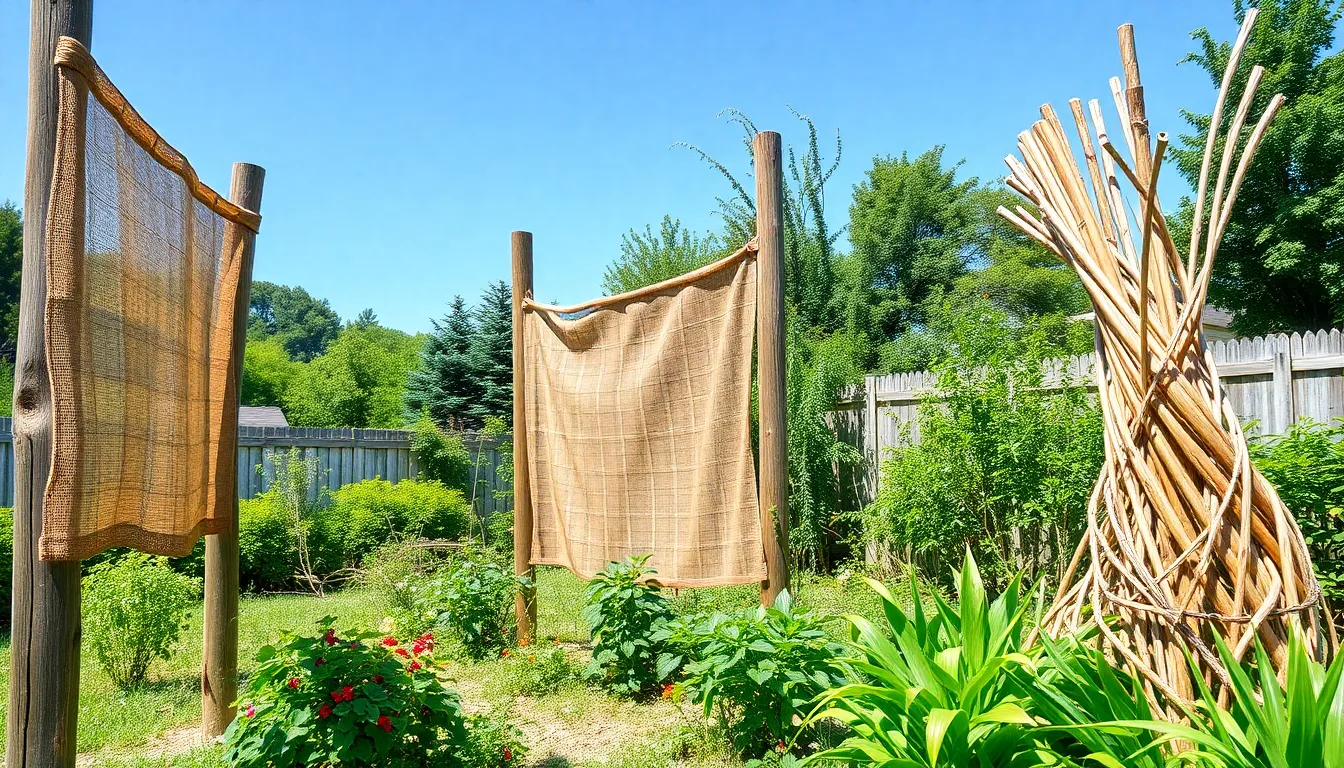
Creating effective wind protection doesn’t require a massive budget. Smart gardeners can build practical windbreaks using affordable materials and strategic planning.
Simple Burlap and Post Windbreak Systems
Simple burlap and post systems offer one of the most cost-effective windbreak answers available. We’ve found that attaching burlap or heavy canvas fabric to wooden posts creates an immediate barrier that blocks harsh winds while allowing gentle airflow through the weave. Reclaimed wood posts keep costs minimal, and you can often find burlap fabric for under $15 at garden centers or hardware stores.
Setting up these systems requires basic tools and takes just a few hours. We recommend spacing posts 6-8 feet apart and securing the burlap with heavy-duty staples or zip ties. The fabric should extend at least 12 inches into the ground or be weighted down with stones to prevent wind from lifting the bottom edge.
This windbreak style works exceptionally well for protecting vegetable gardens and newly planted areas. Canvas provides slightly better durability than burlap, though both materials typically last 2-3 seasons before requiring replacement.
Willow Branch Woven Wind Barriers
Willow branch woven barriers create beautiful natural windbreaks using one of nature’s most flexible materials. We’ve discovered that fresh willow branches can be woven together in a traditional basket-weave pattern to form sturdy wind barriers that cost virtually nothing if you have access to willow trees.
Harvesting willow branches works best during late winter when the sap is down and branches are most pliable. We suggest cutting branches 6-8 feet long and about 1-2 inches thick at the base. The weaving process involves driving vertical stakes into the ground every 2-3 feet, then weaving horizontal branches between them in an alternating over-under pattern.
These living barriers often take root and continue growing, eventually becoming permanent hedgerows. The natural appearance blends seamlessly with garden landscapes, and the irregular weave allows beneficial airflow while blocking strong winds. Maintenance involves occasional trimming and replacing broken branches as needed.
Seedling Tree Windbreaks for Long-Term Investment
Seedling tree windbreaks represent the ultimate long-term investment in garden protection. We’ve learned that purchasing young trees like hawthorn, holly, or yew saplings costs significantly less than mature specimens while providing decades of wind protection once established.
Dense shrub plantings work particularly well for creating graduated wind barriers. We recommend planting seedlings in staggered rows, with faster-growing species like privet or forsythia providing immediate coverage while slower evergreens like yew establish themselves behind them. Most bare-root seedlings cost $5-15 each, making it possible to create substantial windbreaks within budget constraints.
Planning these installations requires patience since full effectiveness takes 3-5 years to develop. But, the long-term benefits include increased property value, wildlife habitat creation, and permanent wind protection that improves with age. We suggest starting with cold-hardy native species that thrive in your exact climate zone to ensure successful establishment and minimal maintenance requirements.
Conclusion
Creating effective windbreaks doesn’t have to be overwhelming or expensive. We’ve explored answers ranging from natural living barriers to innovative DIY projects that can transform your garden’s resilience against harsh winds.
Whether you choose evergreen hedges for year-round protection or temporary fabric screens for immediate relief your garden will benefit from reduced wind damage and improved growing conditions. Multi-purpose designs like trellis windbreaks and pergola structures offer the added bonus of enhanced functionality and aesthetic appeal.
The key is selecting windbreak answers that match your budget timeline and maintenance preferences. With options spanning from budget-friendly burlap barriers under $50 to sophisticated stone walls there’s a perfect windbreak strategy for every garden and gardener.
Start small with temporary answers while planning your long-term windbreak vision. Your plants will thank you for the protection and you’ll enjoy a more comfortable and productive outdoor space year-round.
Frequently Asked Questions
What are windbreaks and why are they important for gardens?
Windbreaks are barriers that protect gardens from strong winds, which can damage plants and disrupt outdoor spaces. They create microclimates, reduce water loss, and provide wildlife habitats. Effective windbreaks not only shield plants from harsh weather but also enhance growing conditions, making gardens more productive and enjoyable year-round.
What are the best living windbreak options for long-term protection?
Living windbreaks include evergreen trees like Norway spruce and arborvitae for year-round coverage, deciduous trees like maple and oak for seasonal protection, and dense shrub hedges such as privet and boxwood. These natural barriers mature over time, becoming increasingly effective while providing ecological benefits and aesthetic appeal.
How do structural windbreaks provide immediate garden protection?
Structural windbreaks offer instant protection using wooden fences with strategic gaps, bamboo screens, or metal mesh barriers. These solutions work immediately while living windbreaks establish themselves. Wooden fences with horizontal slats and controlled airflow gaps provide superior wind reduction compared to solid barriers.
What temporary windbreak solutions work for quick setup?
Temporary windbreaks include fabric and tarp systems, portable bamboo screen panels, and stakes with netting. These options provide immediate protection while permanent solutions develop, can be easily moved or removed based on weather conditions, and offer flexible placement around the garden as needed.
How can I create effective windbreaks using recycled materials?
DIY windbreaks can be made from repurposed windows and doors, plastic bottles, or salvaged wood pallets. These creative solutions combine sustainability with functionality, reducing waste while providing essential wind protection. Old materials can be transformed into decorative screens that diffuse wind while maintaining garden visibility.
What are multi-purpose windbreaks that add value beyond wind protection?
Multi-purpose windbreaks include trellis systems that support climbing plants, garden walls with built-in planters, and pergola structures that create outdoor living spaces. These designs serve multiple functions, enhancing garden aesthetics while providing wind protection and defining comfortable areas for relaxation and dining.
What low-maintenance windbreak options are available for busy gardeners?
Low-maintenance windbreaks include artificial hedge panels, stone and rock walls, gabion barriers, and ornamental grass plantings. These solutions require minimal upkeep while providing effective wind protection. Synthetic materials offer immediate results without watering or pruning, while stone walls provide long-lasting durability.
Can I create effective windbreaks on a tight budget?
Yes, budget-friendly windbreaks under $50 include burlap and post systems, willow branch woven barriers, and seedling tree plantings. These economical solutions provide immediate or long-term protection without significant investment. Young trees and shrubs planted in staggered arrangements create effective windbreaks as they mature.
How do I choose between temporary and permanent windbreak solutions?
Choose temporary windbreaks for immediate protection, seasonal needs, or rental properties. Opt for permanent solutions like living barriers or structural fences for long-term gardens where you can invest in growth over time. Consider combining both approaches: temporary protection while permanent windbreaks establish themselves.
What spacing and placement strategies work best for windbreaks?
Effective windbreaks should be placed perpendicular to prevailing winds, with heights appropriate to the protected area. Living windbreaks benefit from staggered plantings for density, while structural barriers need strategic gaps for controlled airflow. Consider the mature size of plants and local wind patterns when planning placement.

